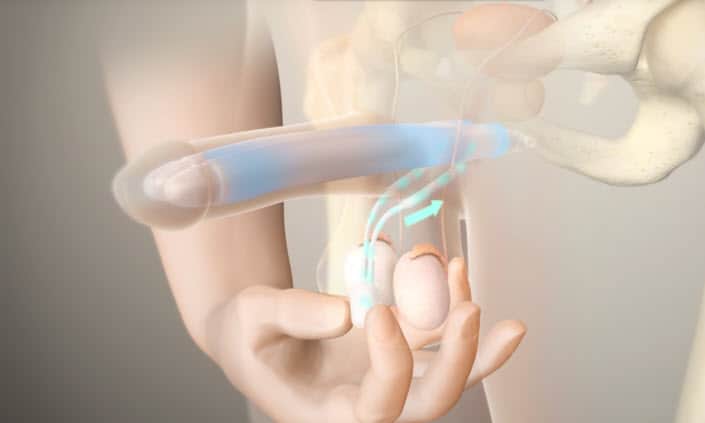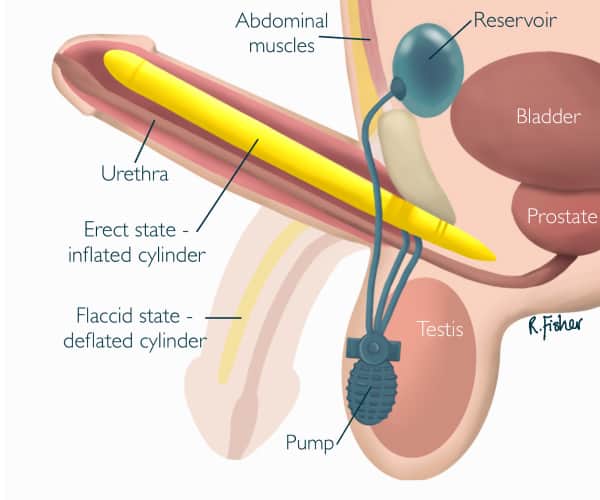Penile prosthesis
What is the penile prosthesis?
The penile prosthesis is a medical device put in the penis's erection chamber (corpora cavernosa) through surgery when a man has trouble getting an erection.
When to Consider Penile Prosthesis Surgery
If the PDE5 inhibitor and intravenous injections didn't work, the penile prosthesis could be a good choice for the patient.
How does the penile prosthesis work?
There are two types of implants: semi-rigid, non-inflatable and inflatable. The semi-rigid prosthesis consists of two cylinders implanted in the corpora cavernosa (the erection chamber of the penis), which can be bent during sexual activity. With this kind of implant, the penis stays in a semi-rigid position all the time, which is hard to hide.
Inflatable penile implants are devices that are filled with liquid. The prosthesis consists of two inflatable cylinders placed in the corpora cavernosa of the penis, a manually controlled pump inserted into the scrotal sack, and a reservoir that holds fluid when the penis is not erect. The device inflates when the pump is squeezed several times to allow fluid to move from the pool to the cylinders. At the end of intercourse, the pump is activated again to send the liquid back into the tank, making the erection disappear.

Both prostheses are surgically implanted and fully positioned in the body. Inflatable implants are used more frequently because they achieve more natural results. In more complex cases, semi-rigid implants may not be suitable. It is recommended that you discuss which type to choose with your urologist.
The penile implant is performed under general or spinal anaesthesia. The patient will be fitted with a catheter, which will be removed the next day. Once the patient is anaesthetised, the surgeon will make a small incision just above the penis or between the penis and scrotum. The incision will show the corpora cavernosa and the surgical spaces to place the implant at the correct length.
The pump is placed in the scrotum between the testicles.
When all the elements are implanted, they are connected and the incision sutured. The wounds are cleaned, and a compression bandage is applied. Most surgeons prefer to leave the penile implant swollen for a day. Others prefer to leave the drainage, which is usually removed after the first day.
Your doctor will provide details of the procedure and its preparation in advance. For precisely 6 hours before the surgery and exactly 6 hours after it, it is forbidden to eat, drink, or smoke to prepare for anaesthesia. If you take any prescription medication, you should discuss it with your doctor. It may be necessary to stop taking it several days before the surgery. Pharmacological treatment can be resumed at the doctor's discretion.
The time needed to return to daily activities
Usually, the patient will be discharged the day following the surgery after the bandage has been removed and the surgeonthe surgeon has deflated the implant has deflated the implant. The patient may experience pain, irritation, and swelling of the penis and scrotum in the days following the surgery or the following weeks.
These symptoms can be managed with painkillers and cold packs. There may be minor losses in the first 2 or 3 days after surgery due to incisions that do not need to be treated because they heal independently.

- Do not lift weights greater than 5 kg.
- Do not exercise and avoid cycling.
- Do not take thermal baths or saunas.
- Discuss any medications to be taken with your doctor.
- The swelling gets worse rather than better.
- There is a constant secretion of purulent fluids from the wounds.
- The pain intensifies or does not improve.
- There is redness or pain in the incised area.
- Fever occurs.
BENEFITS
- Mechanical failure is less likely.
- It is possible to inflate the device with discretion.
- Inflatable implants can be easily hidden.
- No risk of priapism.
- The most satisfactory result among the possible treatments
- There is a higher percentage of satisfied patients among all ED therapies if they are informed, including partners, about the various aspects of the implant.
DISADVANTAGES
- Irreversible operation
- In the case of the removal of the device, there is no possibility of recovering the erectile function.
- The risk of infection, even if minimal,
- The risk of device failure, even if minimal,
- Generally, the inflation implant lasts from 10 to 15 years. It will be possible to replace the device in case of failure.
- Minimum percentage of uncontrolled bleeding after the operation. A second intervention will be required in this case.
- The minimum rate of abnormal scar tissue formation
- A minimal percentage of erosion may require removal.
- The glans may not enlarge during an erection.
- The implant may not swell the penis or correct a previous loss of length due to prostatectomy, radiation, ageing, weight gain or long-term ED therapies.







